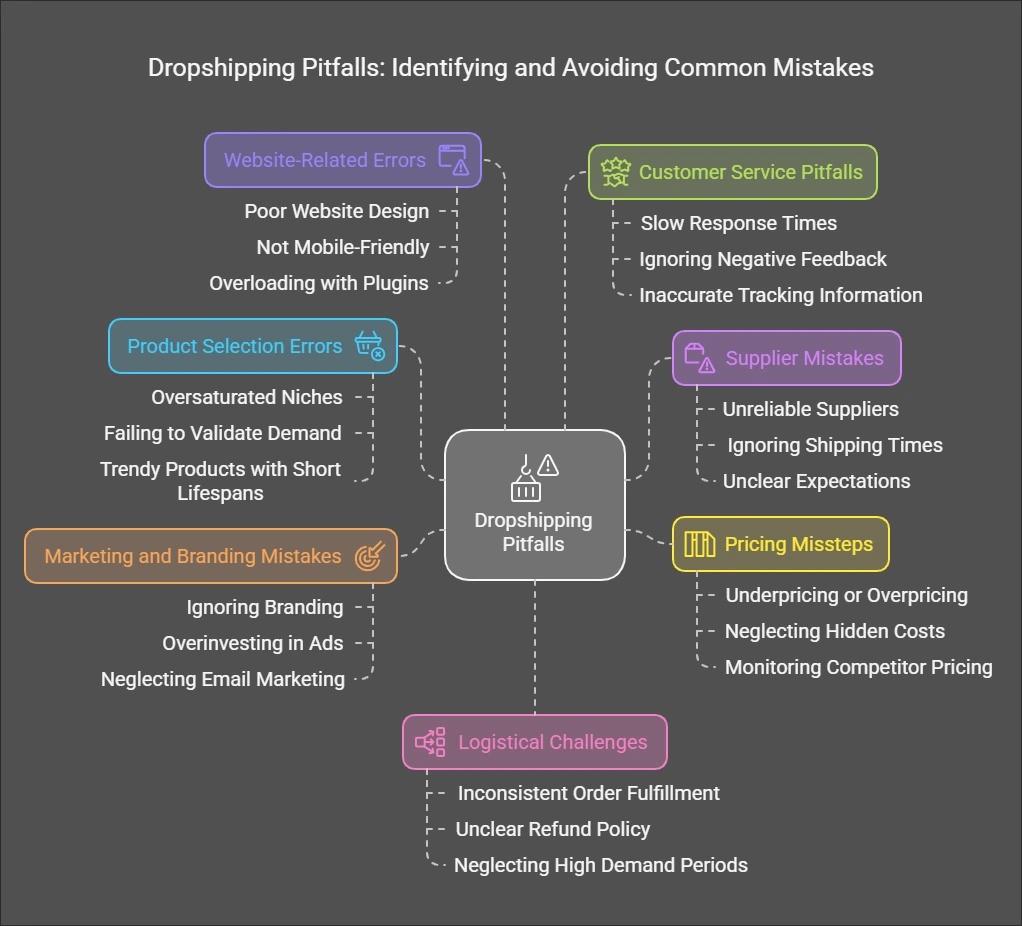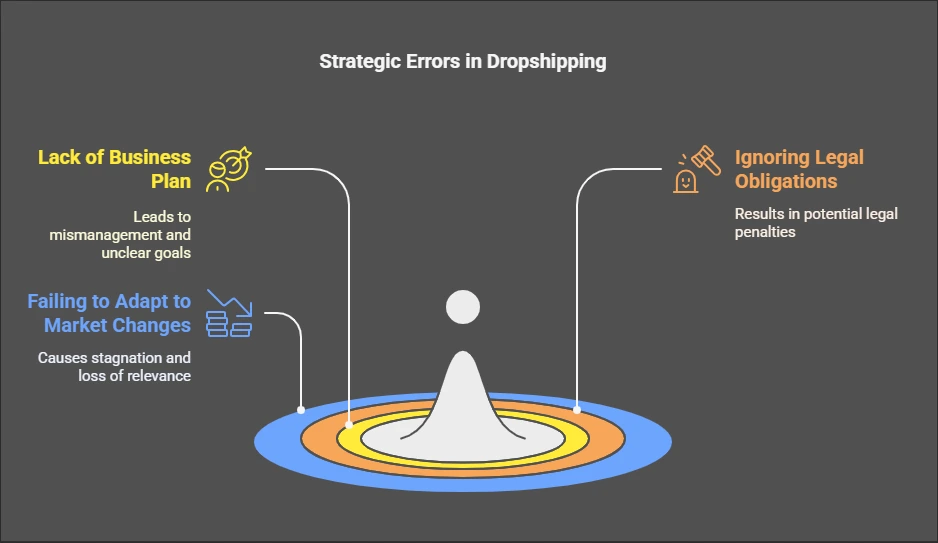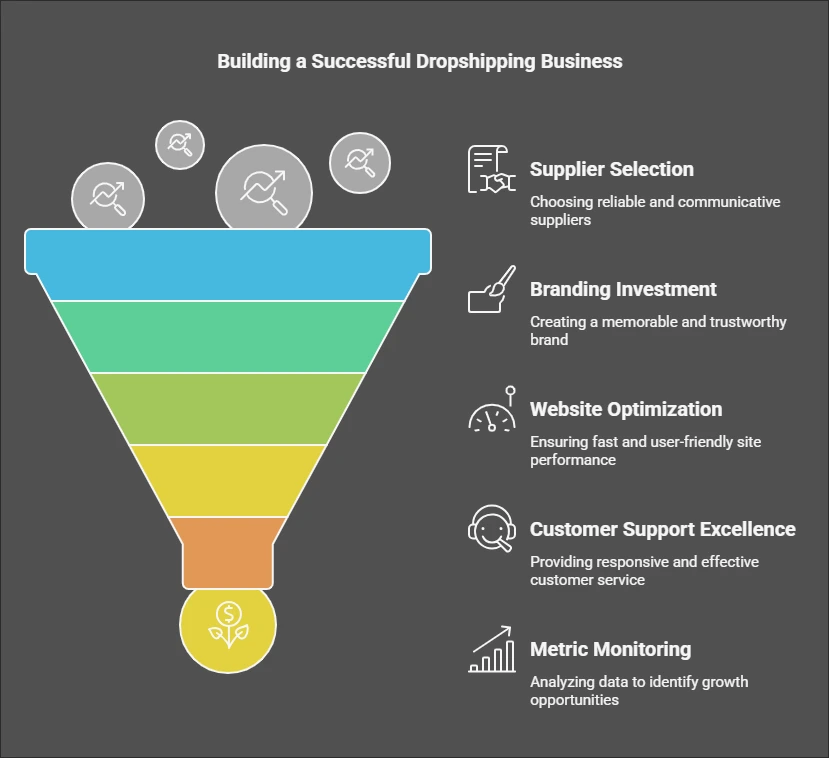Table of Contents
Introduction
When it comes to starting an online business, dropshipping has become one of the most accessible and enticing options. It offers low barriers to entry, minimal upfront investment, and the ability to sell products without holding inventory. But like any business model, it comes with its challenges. If you’re not careful, seemingly small mistakes can snowball into major setbacks for your business.
This guide dives deep into the dropshipping world, unpacking the most common dropshipping pitfalls and how to avoid them. Whether you’re a beginner or someone looking to refine your approach, understanding these missteps can save you time, money, and frustration. Let’s start with the basics.
What is Dropshipping?
A Brief Overview of the Dropshipping Model
Dropshipping is a business model where you, as a retailer, sell products without needing to stock them yourself. Instead, you partner with suppliers who handle inventory, packaging, and shipping directly to your customers. Your role focuses on marketing, customer experience, and managing your online store.
This streamlined setup eliminates the need for large warehouses or significant upfront investment. It’s as simple as finding a product, listing it on your store, and forwarding orders to your supplier once customers make a purchase. Sounds great, right?
Why It’s a Popular Choice for Entrepreneurs
The appeal of dropshipping lies in its flexibility. You can start a business from anywhere with an internet connection. It’s also an excellent choice for those testing new products or markets, as you’re not tied to specific inventory. Plus, the potential for scaling quickly makes it an attractive option for entrepreneurs eager to build a profitable business without hefty overhead costs.
Why Avoiding Mistakes is Critical to Success
While dropshipping sounds easy, it’s far from a “set it and forget it” business. Mistakes can lead to poor customer experiences, financial losses, and even the collapse of your business. For instance, partnering with an unreliable supplier might result in delayed shipments, while ignoring proper market research could leave you stuck with low-demand products.
The goal of this guide is to arm you with the knowledge to navigate these challenges. By understanding common Dropshipping pitfalls and how to sidestep them, you’ll be better positioned to build a thriving dropshipping business.
If you’re looking to start and grow your online business successfully, don’t miss out on our expert guide! Get your copy of “From Zero to Hero: A Step-by-Step Guide to Making Money Online” today and start building your financial freedom. Grab your eBook now!
1. Understanding Dropshipping Basics
How Dropshipping Works
At its core, dropshipping relies on a simple process:
- You list products in your online store that are sourced from suppliers.
- When a customer places an order, you forward the order details to your supplier.
- The supplier packages and ships the product directly to the customer.
Your primary responsibilities include choosing the right products, marketing them effectively, and providing stellar customer support. This hands-off approach to inventory management allows you to focus on growth rather than logistics.
The Pros and Cons of Dropshipping
Pros:
- Low Startup Costs: No need to invest in large amounts of inventory upfront.
- Scalability: Easily expand your product range or customer base.
- Flexibility: Operate from anywhere, giving you freedom and independence.
Cons:
- Tight Margins: Competition can drive prices down, impacting profitability.
- Limited Control: You rely heavily on suppliers for quality, shipping, and inventory management.
- Customer Service Challenges: If something goes wrong with an order, it’s up to you to fix it, even though the issue might lie with the supplier.
Related : The Ultimate Guide: Best Tools to Automate Your Dropshipping Business
2. Common Dropshipping Pitfalls

2.1 Product Selection Errors
Choosing the right product can make or break your business. Here are some common mistakes:
- Choosing Oversaturated Niches: Entering markets with too many competitors makes it difficult to stand out and generate profits.
- Failing to Validate Product Demand: Without adequate research, you might end up selling items no one wants to buy.
- Relying on Trendy Products with Short Lifespans: While trending items can bring quick sales, their demand often fades quickly, leaving you scrambling for the next big thing.
2.2 Supplier Mistakes
Your suppliers are the backbone of your dropshipping business, and errors in this area can have catastrophic consequences:
- Partnering with Unreliable Suppliers: Late deliveries, poor-quality products, and lack of communication can tarnish your reputation.
- Ignoring Supplier Location and Shipping Times: Long shipping durations can frustrate customers and lead to negative reviews.
- Not Communicating Clear Expectations with Suppliers: Misunderstandings about packaging, branding, or delivery timelines can lead to mistakes.
2.3 Pricing Missteps
Getting your pricing strategy wrong can hurt your bottom line:
- Underpricing or Overpricing Products: Low prices might not cover costs, while high prices can deter customers.
- Neglecting to Calculate Hidden Costs: Shipping fees, transaction costs, and taxes can eat into your profits.
- Failing to Monitor Competitor Pricing: Staying competitive requires regular pricing adjustments based on market trends.
2.4 Marketing and Branding Mistakes
Marketing is vital for driving traffic, but these missteps can hold you back:
- Ignoring Branding and Differentiation: Without a unique brand identity, your store risks becoming just another faceless retailer.
- Overinvesting in Ads Without Testing: Pouring money into ads without understanding what works wastes resources.
- Neglecting Email Marketing and Retargeting Strategies: Failing to engage customers post-visit means losing out on potential sales.
2.5 Website-Related Errors
Your website is the first impression of your business. Don’t let these mistakes ruin it:
- Creating a Poorly Designed Website: A cluttered or unprofessional website can drive customers away.
- Failing to Optimize for Mobile Users: With mobile commerce on the rise, a non-mobile-friendly site means lost sales.
- Overloading the Site with Plugins and Scripts: Slow-loading websites frustrate visitors and hurt SEO rankings.
2.6 Customer Service Pitfalls
Great customer service builds trust, but these errors can damage your reputation:
- Slow Response Times to Customer Queries: Customers expect timely support. Delays can result in lost sales.
- Ignoring Negative Reviews and Feedback: Addressing criticism shows you care about improving.
- Failing to Provide Accurate Tracking Information: Customers need to know where their orders are, or frustration mounts.
2.7 Logistical Challenges
Logistics might seem simple, but mishandling them can derail your operations:
- Inconsistent Order Fulfillment: Delays or errors in shipments harm customer trust.
- Not Having a Clear Refund/Return Policy: Lack of transparency frustrates customers and can deter purchases.
- Neglecting to Prepare for High Demand Periods: Without planning, seasonal spikes can overwhelm your operations.
By recognizing and avoiding these pitfalls, you can create a strong foundation for your dropshipping business.
3. Strategic Errors in Dropshipping

Lack of a Business Plan
Related: From Idea to Income: Best AI Tools for Launching Your Online Business
Many entrepreneurs dive into dropshipping without a clear roadmap. Without a business plan, it’s easy to lose focus, mismanage resources, and fail to set realistic goals. A solid business plan should outline your niche, target audience, marketing strategies, revenue goals, and operational procedures. Think of it as your compass—without it, navigating the challenges of dropshipping becomes guesswork.
Ignoring Legal and Tax Obligations
Dropshipping might seem like a casual venture, but it’s still a legitimate business with legal responsibilities. Overlooking the need for proper business registration, tax compliance, and intellectual property considerations can lead to costly penalties or even legal action. Familiarize yourself with local and international regulations, and consult professionals if necessary to ensure your business operates within the law.
Failing to Analyze and Adapt to Market Changes
The eCommerce landscape is constantly evolving, and staying stagnant is a recipe for failure. Market trends, consumer preferences, and competitor strategies shift regularly, and successful dropshippers stay ahead by adapting. Failing to analyze market data and respond to these changes can leave your business behind, struggling to maintain relevance.
4. Tips to Avoid Dropshipping Mistakes

Thorough Market Research and Validation
Before launching your store, invest time in researching your market. Identify niches with sufficient demand and manageable competition. Use tools like Google Trends, keyword research tools, and competitor analysis to validate your product ideas. This groundwork ensures you’re entering a market with growth potential rather than a dead end.
Building Strong Relationships with Reliable Suppliers
Suppliers are the backbone of your business, so choose them wisely. Vet potential suppliers thoroughly by reviewing their track record, communication skills, and willingness to collaborate. Establish clear expectations regarding quality, shipping times, and customer service. A strong partnership with a dependable supplier minimizes operational risks and enhances customer satisfaction.
Investing in Professional Branding
In a crowded market, branding is what sets you apart. Invest in a memorable logo, cohesive color schemes, and a unique voice that resonates with your target audience. Building trust through professional branding creates a lasting impression and encourages repeat business. Remember, customers don’t just buy products—they buy from brands they trust.
Optimizing Website Performance for User Experience
Your website is your storefront, and first impressions matter. Ensure your site is fast, mobile-friendly, and easy to navigate. Eliminate unnecessary plugins or scripts that slow down loading times. A seamless user experience not only boosts conversions but also enhances your credibility as a professional retailer.
Providing Excellent Customer Support
Outstanding customer support can turn one-time buyers into loyal customers. Be responsive to inquiries, proactive in resolving issues, and empathetic in handling complaints. Providing accurate tracking information and offering easy-to-understand return policies builds trust and encourages positive reviews.
Monitoring Key Metrics to Identify Growth Opportunities
Track important metrics such as conversion rates, customer acquisition costs, and average order value. These insights help you understand what’s working and what needs improvement. By analyzing data regularly, you can refine your strategies, optimize spending, and capitalize on growth opportunities.
By avoiding these strategic errors and implementing these practical tips, you can create a sustainable and successful dropshipping business that stands out in a competitive market.
Conclusion
Recap of Key Takeaways
Dropshipping can be a profitable and flexible business model, but it’s not without its challenges. By understanding the basics of dropshipping, avoiding common pitfalls, and addressing strategic errors, you can build a business that’s both sustainable and successful. Key takeaways include:
- Conducting thorough market research to select profitable products.
- Building strong relationships with reliable suppliers.
- Investing in branding, marketing, and website optimization.
- Maintaining excellent customer service and adapting to market changes.
Preparation and continuous improvement are vital. Dropshipping isn’t a “set it and forget it” model—it requires effort, analysis, and adaptability. But with the right mindset and strategies, you can create a thriving business.
Encouragement to Start with Confidence
Every successful entrepreneur began with uncertainty. Don’t let fear of mistakes hold you back. By equipping yourself with knowledge and remaining committed to learning, you’re already setting the foundation for success. Start small, be patient, and celebrate each milestone. Confidence and perseverance will be your greatest assets in this journey.
FAQs
1. Can I start a dropshipping business with little money?
Yes, one of the biggest advantages of dropshipping is its low startup cost. You don’t need to invest in inventory upfront or manage storage, which reduces initial expenses. However, you will need some funds for creating a website, marketing, and possibly subscribing to tools for store management.
2. What are the most reliable tools for managing a dropshipping store?
Popular tools include Shopify, WooCommerce, and BigCommerce for setting up your store. For sourcing products, Oberlo, Spocket, and AliExpress are commonly used. To streamline operations, consider tools like Zendesk for customer support, Google Analytics for tracking performance, and Klaviyo for email marketing.
3. How can I identify trustworthy suppliers?
Research is key. Look for suppliers with positive reviews, reliable communication, and transparent policies. Request samples to assess product quality and shipping times. Platforms like Spocket and SaleHoo are great resources for finding vetted suppliers.
4. How do I handle disputes with customers effectively?
Approach disputes professionally and empathetically. Respond promptly to customer complaints and provide clear solutions, such as refunds, replacements, or tracking updates. Establish clear return and refund policies upfront to set expectations. Maintaining open and respectful communication can often de-escalate issues.
5. What legal considerations should I be aware of in dropshipping?
Ensure your business is properly registered and complies with local tax laws. Be aware of intellectual property rights when choosing products and images. It’s also essential to include clear terms and conditions, privacy policies, and disclaimers on your website to protect your business and inform your customers.
6. What’s the best way to choose a profitable niche for dropshipping?
To choose a profitable niche, start by researching market demand and trends. Use tools like Google Trends, keyword research tools, and competitor analysis to identify niches with consistent interest. Look for products that solve specific problems or cater to passionate audiences, as these are more likely to convert. Avoid overly saturated niches unless you can offer unique value or branding.
7. How long does it take to see profits in dropshipping?
The timeline for profitability varies depending on factors like your marketing efforts, niche, and initial investment. Some entrepreneurs see profits within a few months, while others may take longer to break even. Focus on building a strong foundation by testing products, optimizing your store, and refining your marketing strategy. Consistency and patience are key.
8. Is dropshipping suitable for part-time entrepreneurs?
Yes, dropshipping is an excellent option for part-time entrepreneurs because it doesn’t require managing physical inventory or handling fulfillment. Automated tools can simplify many aspects of the business, allowing you to focus on marketing and customer service during your available time. However, you’ll need to manage your time effectively to handle customer inquiries and monitor store performance.
9. How do I manage shipping times in dropshipping?
Shipping times can be a challenge, especially if your suppliers are overseas. To manage expectations, clearly communicate estimated shipping times on your product pages and in post-purchase emails. Partner with suppliers who offer faster shipping options, and consider working with local suppliers for key products to reduce delivery times. Proactively update customers on their order status to maintain trust.
10. Can I scale my dropshipping business? If so, how?
Yes, scaling a dropshipping business is entirely possible with the right strategies. Once you’ve identified winning products and marketing channels, reinvest profits into expanding your ad campaigns, adding new products, and improving your website. Consider diversifying by targeting new markets or offering upsells and bundles. Monitoring key metrics and automating processes can also help you scale efficiently.
By taking these steps, you can navigate the challenges of dropshipping confidently and effectively. Remember, every challenge is an opportunity to grow and refine your business for long-term success.

